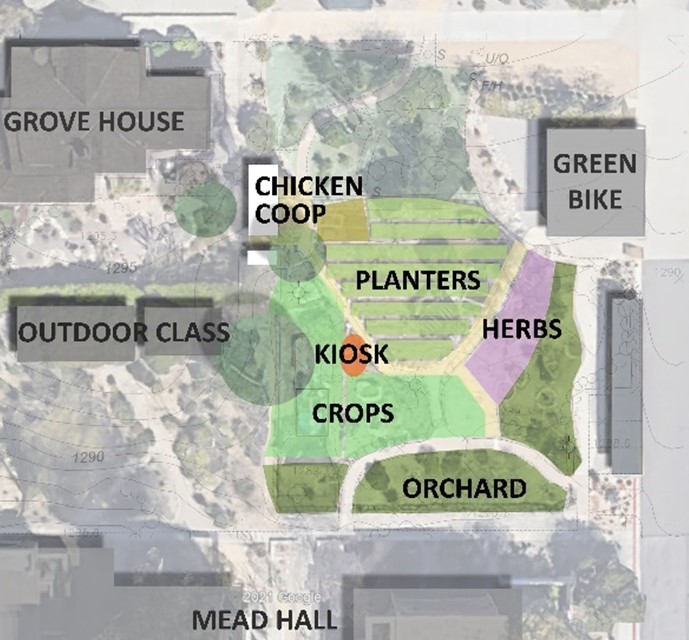Pitzer College’s Student Garden has deep roots, dating back to 1994 when the late Professor John Rodman led the charge to convert the 12,000-square-foot Mead Hall parking lot into a garden with fruit trees, vegetables, and of course, a coop for Pitzer’s chickens-in-residence. Starting with a Community Garden Day, the asphalt was jackhammered and removed, then replaced with “The Farm Project,” an organic garden and orchard. The garden has been tended to and maintained by students ever since, and the chicken coop has been a favorite place for the community to visit and a popular Admission tour stop. Over the years, some of the garden had become fallow, and the absence of students from March 2020 to August 2021 due to the pandemic had not been kind to the space.
Fast forward to today. The Student Garden has sprung back to life, thanks to a community-wide effort and the support of a fundraising campaign for the Student Garden Revitalization Project launched on August 20, 2021.
The vision for the revitalized student garden was developed by students, staff, faculty, and offices across campus, ranging from the Student Garden Club to the Grove House and Robert Redford Conservancy staff to Pitzer’s Office of Facilities and Campus Services. With support from the Office of College Advancement and the Student Garden Fund, the student garden is getting some serious TLC and new equipment, including a more spacious chicken coop—and a Chicken Cam.
Grassroots beginnings
 Proposed project plan
Proposed project planThe idea for the reimagined Student Garden Project began in fall 2019 when a student and community member were walking through the campus and came upon the mostly fallow garden.
Wanting to revitalize this popular space, they contacted Pitzer’s Office of College Advancement to help with funding to reinvigorate the garden area, upgrade the chicken coop, provide plants, supplies, and a storage shed as well as contribute to wages for students who tend to the garden.
The project has grown to areas adjacent to the student garden, including the small fruit orchard on the south side of the space. The garden continues to evolve as Pitzer develops and refines the area. Some of the key concepts and goals are to:
- Remain student-planned, run, and maintained
- Increase learning and teaching demonstration spaces
- Create opportunities for art collaboration and integration into the curriculum, such as a dye garden and a chicken coop mural
- Preserve and enhance the visibility of landmarks in and surrounding the garden, such as the Workers’ Memorial Garden
- Design more welcoming and inviting points of entry for students and visitors, with better cross connections, flow, and aesthetics
- Install an informational kiosk and interpretive plant signage
- Expand the garden beds to accommodate a variety of fruits, herbs, and vegetables, including marketable crops such as lavender
- Designate an area for building soil, composting, and exploring different gardening methods
Special thanks to the Student Garden Working Group:
- Callie Radecki ’22 – Student Garden Club member and RRC Fellow
- Anthony Shing ’24 – Student Senate Sustainability representative
- Em Kuhn ’22 – former Student Senate Sustainability representative
- Arthur Levine ’14 – Redford Conservancy Fellow in Applied Research-Sustainable Agriculture
- Zenia Gutierrez – Grove House Manager
- Holly Preble – Senior Philanthropic Advisor (retired), Office of Advancement
- Susan Phillips – Professor, Environmental Analysis / Urban Studies, Interim Director Robert Redford Conservancy
- Steve Lang – MIG, Landscape Architect
- John Beck – Carrier Johnson + Culture Architects
- Patrice Langevin – Assistant Vice President of Facilities